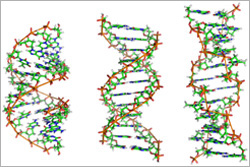
Invasive fungal infections—the kind that infect the bloodstream, lung and brain—are inordinately deadly. A big part of the problem is the lack of drugs that are both effective against the fungi and nontoxic to humans.
The situation might change in the future though, thanks to the work of a multidisciplinary research team led by chemist Martin Burke at the University of Illinois. For years, the team has focused on an antifungal agent called amphotericin B (AmB for short). Although impressively lethal to fungi, AmB is also notoriously toxic to human cells.
Most recently, the research team chemically modified the drug to create compounds that kill fungi, but don’t disrupt human cells. The scientists explain it all in the latest issue of Nature Chemical Biology.
Invasive fungal infections are so intractable because most antifungal drugs aren’t completely effective. Plus, fungi have a tendency to develop resistance to them. AmB is a notable exception. Isolated 50 years ago from Venezuelan dirt, AmB has evaded resistance and remains highly effective. Unfortunately, it causes side effects so debilitating that some doctors call it “ampho-terrible.” At high doses, it is fatal.
For decades, scientists believed that AmB molecules kill fungal cells by forming membrane-piercing pores, or ion channels, through which the cells’ innards leak out. Last year, Burke’s group overturned this well-established concept using evidence from nuclear magnetic resonance, chemistry and cell-based experiments. The researchers showed that AmB molecules assemble outside cells into lattice-like structures. These structures act as powerful sponges, sucking vital lipid molecules, called ergosterol, right out of the fungal cell membrane, destroying the cell. Continue reading “Designing Drugs That Kill Invasive Fungi Without Harming Humans”




